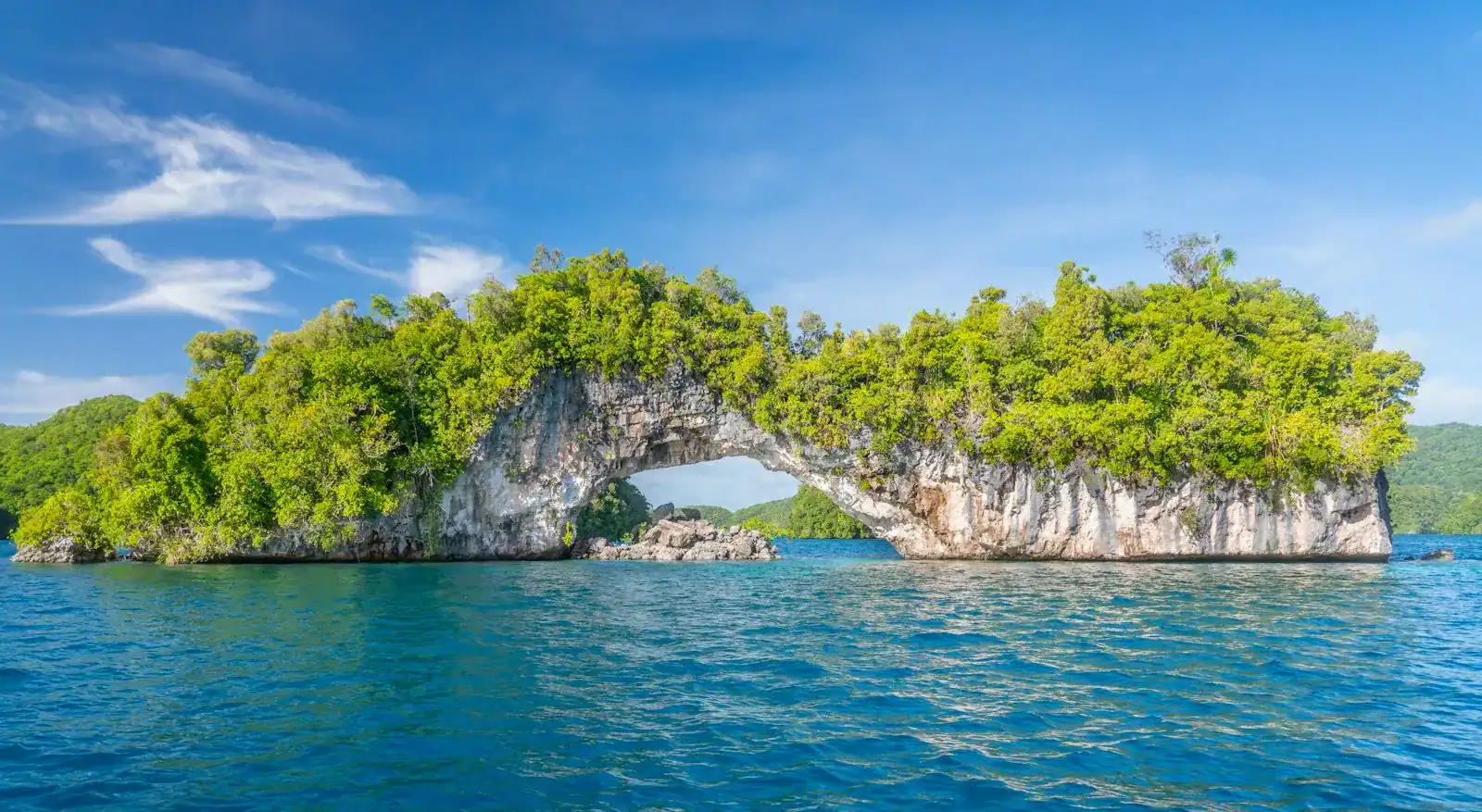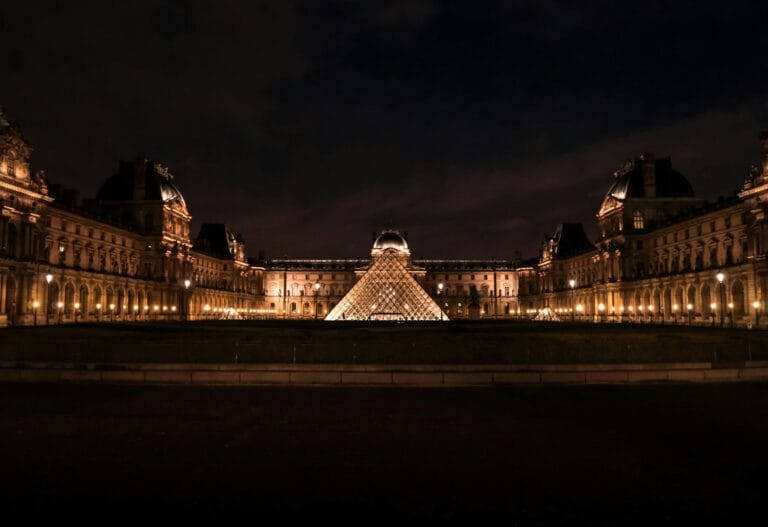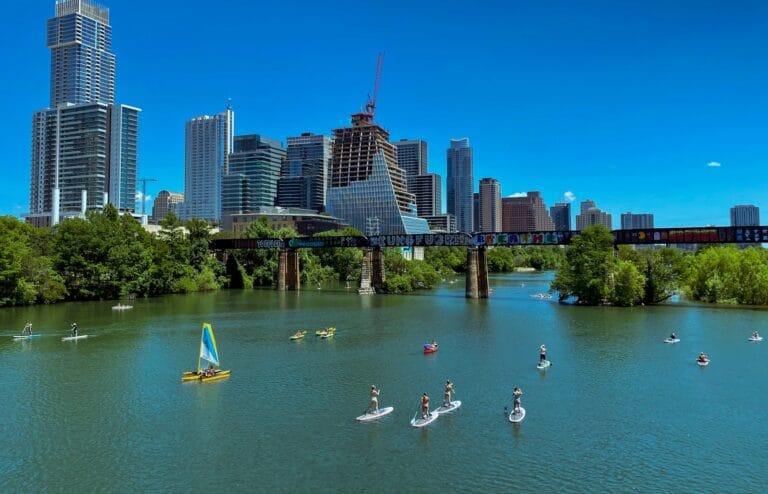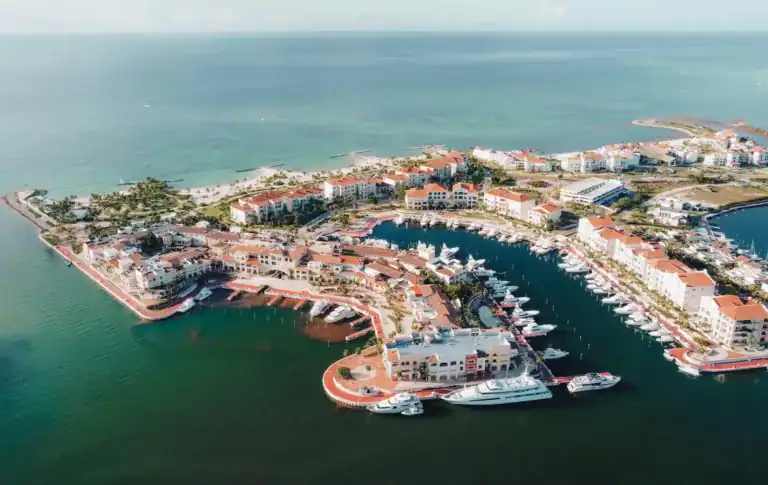Palau Travel Guide: Lagoons, Legends & Ocean Wonders
Intro to Palau Travel Guide
Palau is an island nation where sapphire seas meet limestone cliffs, and ancient legends intertwine with modern conservation. Located in western Micronesia, the Republic of Palau is composed of over 300 islands scattered across the Pacific Ocean. It is a destination of contrasts — at once a diver’s paradise and a place of profound cultural traditions.
Renowned for its pioneering conservation, Palau created one of the world’s first shark sanctuaries and requires every visitor to sign the Palau Pledge, committing to protect its fragile ecosystem. The Rock Islands Southern Lagoon, a UNESCO World Heritage site, is only the beginning — Palau also offers jungles, stone monoliths, WWII battlefields, and thriving village life.
From drift dives among sharks to kayaking through hidden lagoons, Palau rewards travelers with experiences both thrilling and grounding. Start planning with our complete Palau Travel Guide — and explore how to journey responsibly through one of the Pacific’s most enchanting nations.
Where to Go in Palau
Angaur | Hatohobei | Kayangel | Koror | Ngarchelong | Ngardmau | Ngatpang | Ngchesar | Ngeremlengui | Ngiwal | Peleliu | Sonsorol | Airai | Melekeok
💡Quick Facts:
Destination: Palau
Continent: Oceania (Micronesia region, western Pacific)
Country: Republic of Palau (sovereign nation, Compact of Free Association with U.S.)
Administrative Division: 16 states across ~340 islands
Area: 459 km²
Population: ~18,000
Density: ~39/km²
Capital: Ngerulmud (Melekeok State, Babeldaob Island)
Largest City/Hub: Koror (former capital, economic center)
Regions/Subregions:
Koror: Main city, tourism hub, Rock Islands
Babeldaob: Largest island, capital Ngerulmud, rural villages
Peleliu & Angaur: WWII historic sites
Rock Islands Southern Lagoon (UNESCO site): Iconic limestone islands and marine lakes
Official Languages: Palauan, English
Currency: U.S. Dollar (USD, $)
Time Zone: PWT (UTC+9)
Airports: Roman Tmetuchl International Airport (ROR) – Koror/Babeldaob
Climate: Tropical rainforest; hot and humid year-round
Known For: Rock Islands, Jellyfish Lake, WWII history, world-class scuba diving
🛂Arrival Info:
Visa-free or visa-on-arrival: 30 days for most nationalities (extendable up to 90).
U.S. citizens: 1-year stay permitted.
Passport must be valid for 6 months beyond entry.
Palau requires a “Pristine Paradise Environmental Fee” (included in airfare).
Official info: Palau Immigration
🏥Health Info:
No mandatory vaccines; recommended: Hepatitis A, Typhoid, routine immunizations.
Dengue outbreaks possible, especially in rainy season.
Main hospital: Belau National Hospital (Koror).
Limited facilities outside Koror/Babeldaob.
Travel insurance with evacuation coverage strongly recommended.
🚑 Check travel insurance options for travel emergencies, delays, and medical needs abroad — Get coverage here
💉 Stay Informed with Official Updates: WHO – International Travel & Health | CDC – Travel health updates
🚨Travel Advisory:
Palau is very safe with low crime rates.
Petty theft rare but possible in urban centers.
Cyclone risk: June–December (though less frequent than western Pacific neighbors).
Marine risks: strong currents, jellyfish (except non-stinging Jellyfish Lake).
🌍Track Real-Time Official Updates: US Travel Advisory | UK Foreign Travel Advice | Government of Canada
🥳Holidays:
Independence Day (1 October): Celebrates independence from U.N. trusteeship in 1994.
Constitution Day (9 July).
Martyrs’ Day (23 March): WWII commemoration.
Christmas Day (25 December).
💰Visitor Info:
Currency: U.S. Dollar (USD).
ATMs limited; available in Koror.
Credit cards accepted in hotels/resorts; cash needed for small shops.
Tipping not customary.
Daily budget:
Budget: $80–120
Midrange: $150–250
Luxury: $300+
🛫Airports:
Roman Tmetuchl International (ROR): Main international airport near Koror.
Direct flights from Guam, Manila, Taipei, Tokyo, and seasonal routes.
Small airstrips serve remote states by charter flights.
🧳 Delayed or canceled flight? Check if you’re eligible for compensation
🚍Transport:
Car rentals common in Koror and Babeldaob.
Driving: right-hand traffic, U.S. license valid.
No public buses; taxis available but limited.
Domestic travel between states mainly by boat.
Ferries and charters connect outer islands.
🚗 Book reliable airport transfers and in-city rides in advance. Reserve your ride here
🛰️Connectivity:
SIM providers: PNCC (Palau National Communications Corp.), PalauTel.
Mobile coverage: good in Koror, weaker in outer islands.
Wi-Fi available in hotels, cafes, and airports.
Internet speeds moderate, often slower in rural areas.
🛜 Stay connected abroad with affordable eSIM data packs. Get your eSIM here
📜Laws & Etiquette:
Legal drinking age: 21.
Palau has strict environmental protection laws (plastic bag ban, sunscreen restrictions).
Modest dress in villages and government areas.
Respect chiefs and village customs.
Do not disturb WWII relics or sacred sites.
👮Emergency Info:
Emergency number: 911.
Belau National Hospital (Koror): +680 488 2552.
Palau Visitors Authority: +680 488 1930.
U.S. Embassy in Koror: +680 587 2920.
🏛️ Use embassy locator tools: Embassies Worldwide
🌞Weather:
Average temperature: 27–30°C year-round.
Dry season: Nov–May (best travel period).
Wet season: Jun–Oct, with higher rainfall and humidity.
Diving possible year-round; visibility often >30m.
🌦️ Stay prepared—check the weather forecast for your destination — Weather Forecast
Palau by Region – Where to Go
Palau is divided into 16 states, but most visitors explore four key areas: Koror, Babeldaob, Peleliu, and the Rock Islands. Remote northern and southern atolls add further adventure.
Koror
Koror is the beating heart of Palau, home to 70% of the population and most accommodations, restaurants, and dive shops.
- Koror Town. A lively hub with shops, cafes, and the port for excursions.
- Belau National Museum. Established in 1955, it’s the oldest museum in Micronesia, showcasing navigation tools, traditional bai (men’s meeting houses), and Palau’s political history.
- Etpison Museum. Focuses on Palauan culture, from weaving to canoe building.
- Aquarium of Palau. Displays reef systems, ideal for families before diving trips.
- Night Markets. Weekly gatherings where locals serve grilled fish, taro dishes, and handicrafts.
Babeldaob
The largest island, Babeldaob is rural and less visited but filled with natural and cultural treasures.
- Ngerulmud. Palau’s modern capital, one of the least-populated capitals in the world.
- Badrulchau Monoliths. Basalt stone pillars arranged across a hilltop, dating back over 1,000 years, shrouded in myth.
- Ngardmau Waterfall. Micronesia’s tallest waterfall, accessible via a rainforest trek.
- Lake Ngardok Nature Reserve. Palau’s largest freshwater lake, home to crocodiles and rare birds.
- Airai Bai. A reconstructed traditional meeting house covered in colorful mythological paintings.
- Coastal Villages. Fishing communities offering glimpses of Palau’s slower, rural life.
Rock Islands (Chelbacheb)
Scattered between Koror and Peleliu, these 445 limestone islets are Palau’s crown jewel.
- Jellyfish Lake. Famous for millions of non-stinging jellyfish, a unique snorkeling experience (lake openings depend on conservation status).
- Milky Way Lagoon. Known for mineral-rich white mud used as a natural spa treatment.
- Blue Corner. A world-renowned dive site with strong currents, reef hooks, and abundant sharks, tuna, and barracuda.
- German Channel. Originally blasted by Germans for shipping, now a hotspot for manta rays.
- Clam City. Home to giant clams the size of bathtubs, thriving on sandy bottoms.
Peleliu
A quiet island today, Peleliu was the site of one of the bloodiest WWII battles.
- Peleliu Battlefield. Preserved relics of tanks, bunkers, and airstrips from the 1944 U.S.-Japanese conflict.
- Peleliu WWII Museum. Photographs and artifacts tell the story of the island’s devastating war past.
- Peleliu Beaches. Remote stretches perfect for snorkeling and reflection.
Angaur, Kayangel & Remote Islands
- Angaur. Known for its population of feral monkeys and WWII relics.
- Kayangel Atoll. A northern coral atoll with pristine reefs, white-sand beaches, and small fishing villages.
- Sonsorol & Hatohobei. Extremely remote southern islands, reached only by long boat journeys or charter flights. These preserve traditional Micronesian life with minimal outside influence.
Top Places to Visit in Palau
Palau’s attractions blend nature, history, and culture.
- Rock Islands Southern Lagoon. A UNESCO site of karst islets, hidden coves, and aquamarine waters.
- Jellyfish Lake. A surreal swim among millions of jellyfish drifting with the sun.
- Blue Corner. The ultimate drift dive with pelagic encounters.
- Ngardmau Waterfall. A jungle hike leads to the tallest cascade in Micronesia.
- Badrulchau Monoliths. Palau’s own Stonehenge, wrapped in legend.
- German Channel. Snorkel or dive with graceful manta rays.
- Milky Way Lagoon. Cover yourself in mineral-rich mud in a playful natural spa.
- Peleliu WWII Sites. Explore tanks, bunkers, and memorials of the 1944 battle.
- Kayangel Atoll. A remote paradise for snorkeling, fishing, and cultural immersion.
- Belau National Museum. Connect with Palau’s cultural foundations.
Discover must-try Palau tours that highlight these sites — from WWII heritage walks and lagoon kayaking to full-day dive expeditions in the Rock Islands.
How to Choose Where to Go in Palau
- For Divers. Base in Koror for access to Blue Corner, German Channel, and multiple dive operators.
- For Culture. Spend time in Babeldaob exploring stone monoliths, bai houses, and village life.
- For History. Visit Peleliu to walk through WWII battlefields and reflect on a pivotal Pacific campaign.
- For Seclusion. Escape to Kayangel Atoll or plan an expedition to Sonsorol.
A one-week trip blends Koror’s museums and Rock Islands with Babeldaob’s cultural depth. Two weeks allow for diving, WWII history, and remote atoll adventures.
How to Get Around Palau
- Flights. Palau International Airport (ROR) near Koror connects with Guam, Manila, Taipei, and Tokyo. No regular domestic flights — all main islands are accessible by boat or road.
- Boats & Ferries. Essential for Rock Islands, Kayangel, and Peleliu. Most are organized via tour operators.
- Cars. Rentals (USD 50–70/day) are best for exploring Babeldaob’s roads and remote cultural sites.
- Taxis. Available in Koror but expensive for long journeys.
- Kayaks. A favored way to see lagoons and secluded beaches.
Tip: Roads on Babeldaob are scenic but winding — drive slowly and bring water for long journeys.
Travel Budget and Costs in Palau
Palau is pricier than many Pacific islands, reflecting its remoteness and conservation focus.
- Budget (USD 60–90/day). Guesthouses, local food stalls, shared boat tours.
- Mid-range (USD 150–250/day). Hotels, dive trips, guided cultural tours.
- Luxury (USD 300–600+/day). Resorts, private charters, and dive packages.
Sample costs:
- Meal in Koror: USD 8–15
- Night market plate: USD 5–8
- Boat tour: USD 80–150
- Dive (2 tanks): USD 120–180
- Car rental: USD 50–70/day
- Kayak: USD 30–50/day
Saving tips: Book dive packages, bring reef-safe sunscreen to avoid overpriced imports, and eat at Koror’s markets.
Best Time to Visit Palau
Palau’s warm, humid climate makes it a year-round destination, but conditions vary.
- Dry Season (Nov–April). Best time to visit Palau, with calmer seas, excellent visibility for diving (20–40 meters), and more stable weather. Peak tourism season.
- Wet Season (May–Oct). More rainfall, greener landscapes, and fewer crowds. Diving remains excellent, though seas can be rough.
- Whale Shark Season (Feb–April). Occasional sightings near outer reefs.
Events:
- Independence Day (Oct 1). Celebrations across the islands.
- Belau Fair. Annual cultural event with food, dance, and crafts.
- Canoe Festivals. Highlight Palau’s seafaring traditions.
Seasonal tips:
- Nov–Dec. Ideal for kayaking Rock Islands.
- Jan–April. Best diving visibility, manta encounters.
- May–Aug. Lush jungles, but higher humidity.
- Sept–Oct. Quieter, with local festivals.
Must-See Experiences in Palau
- Drift dive Blue Corner, using reef hooks to watch sharks and tuna glide past.
- Snorkel Jellyfish Lake, floating in a dreamlike swarm.
- Kayak hidden lagoons in the Rock Islands.
- Trek to Ngardmau Waterfall, passing old railway tracks.
- Smear white mud at Milky Way Lagoon.
- Visit Peleliu Battlefields with a guide who explains the 1944 campaign.
- See the Badrulchau Monoliths, Palau’s ancient mystery.
- Snorkel the German Channel, a manta cleaning station.
- Explore traditional bai houses in Babeldaob.
- Share grilled reef fish at Koror’s night market.
Book immersive Palau tours and experience unforgettable things to do in Palau — from shark dives and lagoon kayaking to WWII history and sacred monoliths.
Best Travel Itineraries in Palau
3-Day Lagoon & Culture
- Day 1: Koror town + Belau Museum.
- Day 2: Rock Islands tour with Jellyfish Lake + Milky Way.
- Day 3: Blue Corner diving or Babeldaob day trip.
5-Day Ocean & Heritage
- Day 1: Koror highlights.
- Day 2: Rock Islands kayaking.
- Day 3: German Channel dive.
- Day 4: Babeldaob (monoliths, waterfall).
- Day 5: Peleliu WWII tour.
7-Day Classic Palau
- Days 1–2: Rock Islands kayaking + lagoon tours.
- Days 3–4: Diving Blue Corner + manta encounters.
- Day 5: Babeldaob culture + nature.
- Day 6: Peleliu WWII history.
- Day 7: Kayangel Atoll remote escape.
10-Day Extended Exploration
- Combine multiple dive days, Rock Islands kayaking, Babeldaob cultural immersion, Peleliu WWII tours, and expeditions to Angaur or Kayangel.
Local Cuisine and Culinary Experiences
Palau’s food reflects island traditions and global influences.
- Taro & Cassava. Starchy staples baked or boiled.
- Fresh Tuna & Reef Fish. Served grilled, raw, or in coconut-based stews.
- Fruit Bat Soup. A Palauan delicacy, reflecting resourcefulness.
- Ulkemang. Taro leaves cooked with coconut milk.
- Tropical Fruits. Bananas, papayas, breadfruit, and coconuts.
- Asian Fusion. Japanese sashimi and Filipino adobo, thanks to regional ties.
Best ways to taste: Night markets in Koror, homestays in Babeldaob, and seafood restaurants serving fresh tuna sashimi.
Travel Safety and Cultural Etiquette in Palau
- Safety. Very safe; diving currents are the main risk.
- Weather. Typhoon risk May–Nov, though rare.
- Etiquette. Modesty in villages; swimwear is for beaches only.
- Palau Pledge. Every visitor signs a pledge in their passport to protect Palau’s environment.
- Respect. Ask before entering villages or sacred sites. Treat WWII relics as memorials.
Where to Go Next
Palau connects well with nearby hubs.
- Guam. U.S. territory with modern resorts and flight links.
- Philippines. Manila is a vibrant hub for onward travel.
- Japan. Historical ties and easy connections.
- Federated States of Micronesia. Extend to Chuuk or Yap for diving.
Guam Travel Guide | Philippines Travel Guide | Japan Travel Guide | Federated States of Micronesia Travel Guide
Final Planning Checklist for Palau
- Sign the Palau Responsible Tourism Pledge on arrival.
- Book dive packages early, especially for Blue Corner.
- Reserve Rock Islands tours before peak season.
- Carry reef-safe sunscreen — standard sunscreen is banned.
- Bring cash; ATMs are limited outside Koror.
- Pack water shoes for rocky beaches and waterfalls.
- Rent a car to explore Babeldaob’s cultural sites.
- Download offline maps before rural trips.
- Respect WWII sites and memorials.
- Get travel insurance covering diving and kayaking.
Palau is more than a dive destination — it is a nation of legends, conservation, and living culture. Use this guide to plan responsibly, explore deeply, and experience one of the Pacific’s most extraordinary archipelagos.









